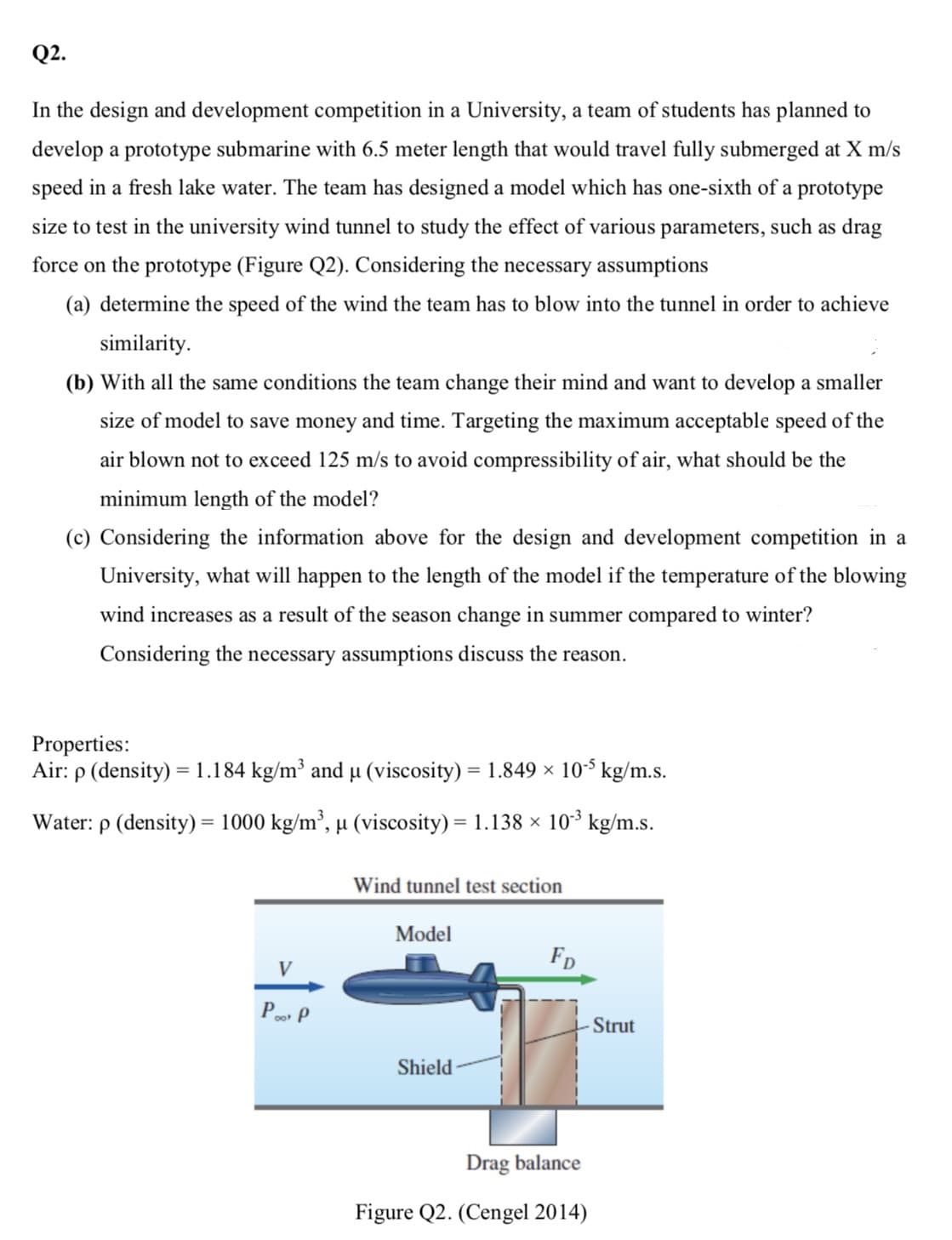Q2. In the design and development competition in a University, a team of students has planned to develop a prototype submarine with 6.5 meter length that would travel fully submerged at X m/s speed in a fresh lake water. The team has designed a model which has one-sixth of a prototype size to test in the university wind tunnel to study the effect of various parameters, such as drag force on the prototype (Figure Q2). Considering the necessary assumptions (a) determine the speed of the wind the team has to blow into the tunnel in order to achieve similarity. (b) With all the same conditions the team change their mind and want to develop a smaller size of model to save money and time. Targeting the maximum acceptable speed of the air blown not to exceed 125 m/s to avoid compressibility of air, what should be the minimum length of the model? (c) Considering the information above for the design and development competition in a University, what will happen to the length of the model if the temperature of the blowing wind increases as a result of the season change in summer compared to winter?
Q2. In the design and development competition in a University, a team of students has planned to develop a prototype submarine with 6.5 meter length that would travel fully submerged at X m/s speed in a fresh lake water. The team has designed a model which has one-sixth of a prototype size to test in the university wind tunnel to study the effect of various parameters, such as drag force on the prototype (Figure Q2). Considering the necessary assumptions (a) determine the speed of the wind the team has to blow into the tunnel in order to achieve similarity. (b) With all the same conditions the team change their mind and want to develop a smaller size of model to save money and time. Targeting the maximum acceptable speed of the air blown not to exceed 125 m/s to avoid compressibility of air, what should be the minimum length of the model? (c) Considering the information above for the design and development competition in a University, what will happen to the length of the model if the temperature of the blowing wind increases as a result of the season change in summer compared to winter?
Elements Of Electromagnetics
7th Edition
ISBN:9780190698614
Author:Sadiku, Matthew N. O.
Publisher:Sadiku, Matthew N. O.
ChapterMA: Math Assessment
Section: Chapter Questions
Problem 1.1MA
Related questions
Question
X = 1

Transcribed Image Text:Q2.
In the design and development competition in a University, a team of students has planned to
develop a prototype submarine with 6.5 meter length that would travel fully submerged at X m/s
speed in a fresh lake water. The team has designed a model which has one-sixth of a prototype
size to test in the university wind tunnel to study the effect of various parameters, such as drag
force on the prototype (Figure Q2). Considering the necessary assumptions
(a) determine the speed of the wind the team has to blow into the tunnel in order to achieve
similarity.
(b) With all the same conditions the team change their mind and want to develop a smaller
size of model to save money and time. Targeting the maximum acceptable speed of the
air blown not to exceed 125 m/s to avoid compressibility of air, what should be the
minimum length of the model?
(c) Considering the information above for the design and development competition in a
University, what will happen to the length of the model if the temperature of the blowing
wind increases as a result of the season change in summer compared to winter?
Considering the necessary assumptions discuss the reason.
Properties:
Air: p (density) = 1.184 kg/m³ and u (viscosity) = 1.849 × 10³ kg/m.s.
Water: p (density) = 1000 kg/m³, µ (viscosity) = 1.138 × 10³ kg/m.s.
Wind tunnel test section
Model
Fp
V
Strut
Shield
Drag balance
Figure Q2. (Cengel 2014)
Expert Solution
This question has been solved!
Explore an expertly crafted, step-by-step solution for a thorough understanding of key concepts.
Step by step
Solved in 5 steps

Knowledge Booster
Learn more about
Need a deep-dive on the concept behind this application? Look no further. Learn more about this topic, mechanical-engineering and related others by exploring similar questions and additional content below.Recommended textbooks for you

Elements Of Electromagnetics
Mechanical Engineering
ISBN:
9780190698614
Author:
Sadiku, Matthew N. O.
Publisher:
Oxford University Press

Mechanics of Materials (10th Edition)
Mechanical Engineering
ISBN:
9780134319650
Author:
Russell C. Hibbeler
Publisher:
PEARSON

Thermodynamics: An Engineering Approach
Mechanical Engineering
ISBN:
9781259822674
Author:
Yunus A. Cengel Dr., Michael A. Boles
Publisher:
McGraw-Hill Education

Elements Of Electromagnetics
Mechanical Engineering
ISBN:
9780190698614
Author:
Sadiku, Matthew N. O.
Publisher:
Oxford University Press

Mechanics of Materials (10th Edition)
Mechanical Engineering
ISBN:
9780134319650
Author:
Russell C. Hibbeler
Publisher:
PEARSON

Thermodynamics: An Engineering Approach
Mechanical Engineering
ISBN:
9781259822674
Author:
Yunus A. Cengel Dr., Michael A. Boles
Publisher:
McGraw-Hill Education

Control Systems Engineering
Mechanical Engineering
ISBN:
9781118170519
Author:
Norman S. Nise
Publisher:
WILEY

Mechanics of Materials (MindTap Course List)
Mechanical Engineering
ISBN:
9781337093347
Author:
Barry J. Goodno, James M. Gere
Publisher:
Cengage Learning

Engineering Mechanics: Statics
Mechanical Engineering
ISBN:
9781118807330
Author:
James L. Meriam, L. G. Kraige, J. N. Bolton
Publisher:
WILEY